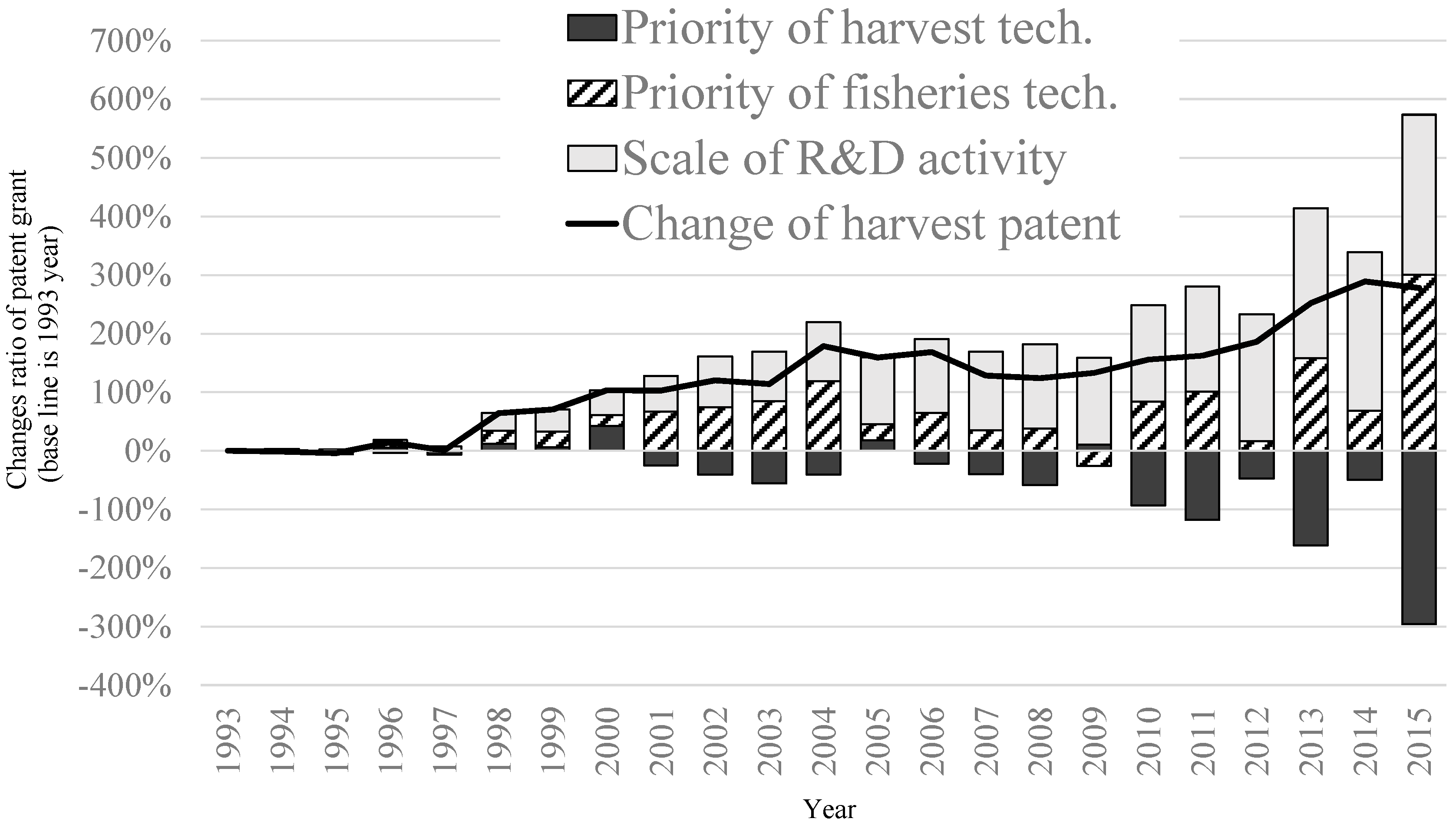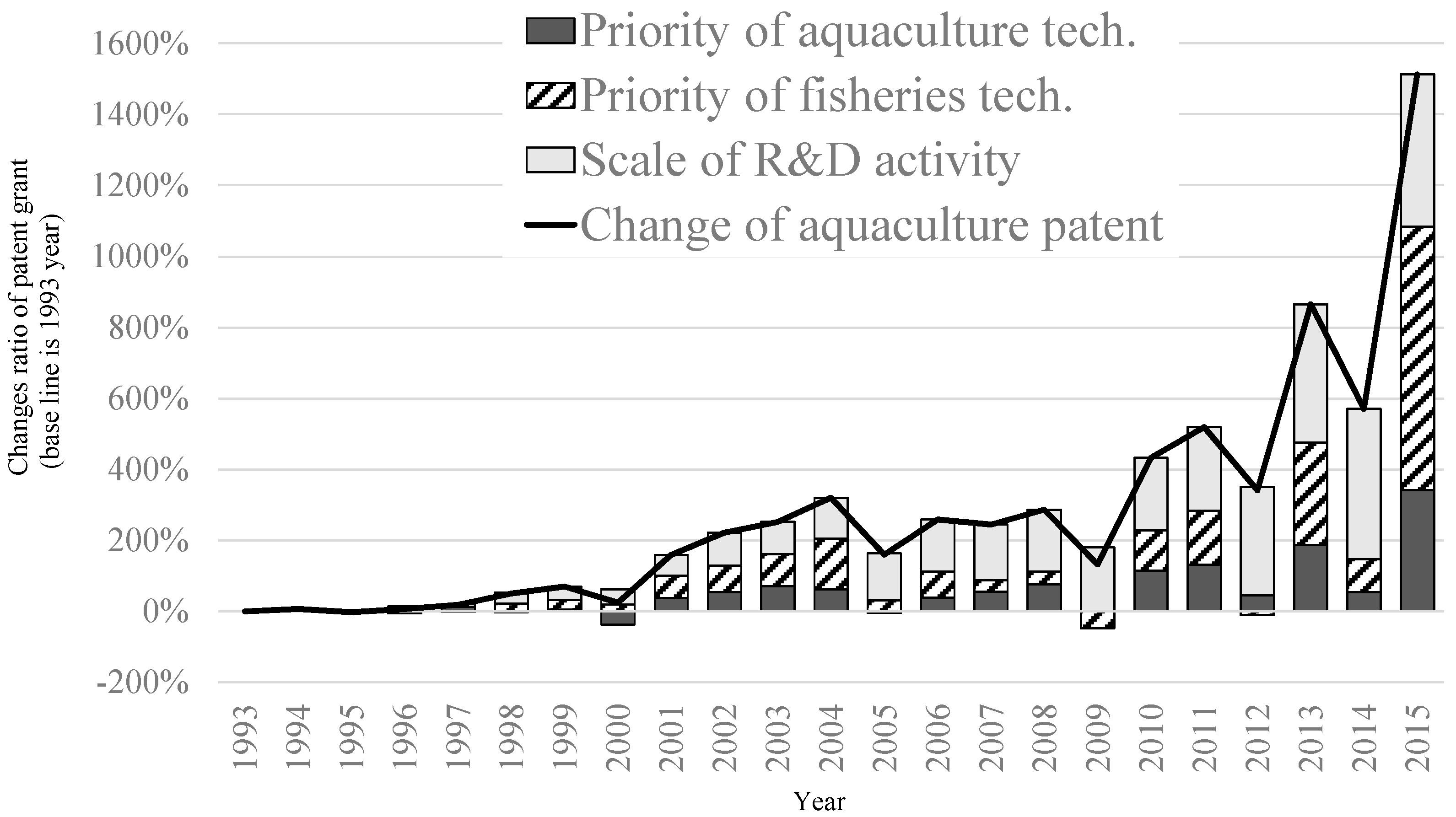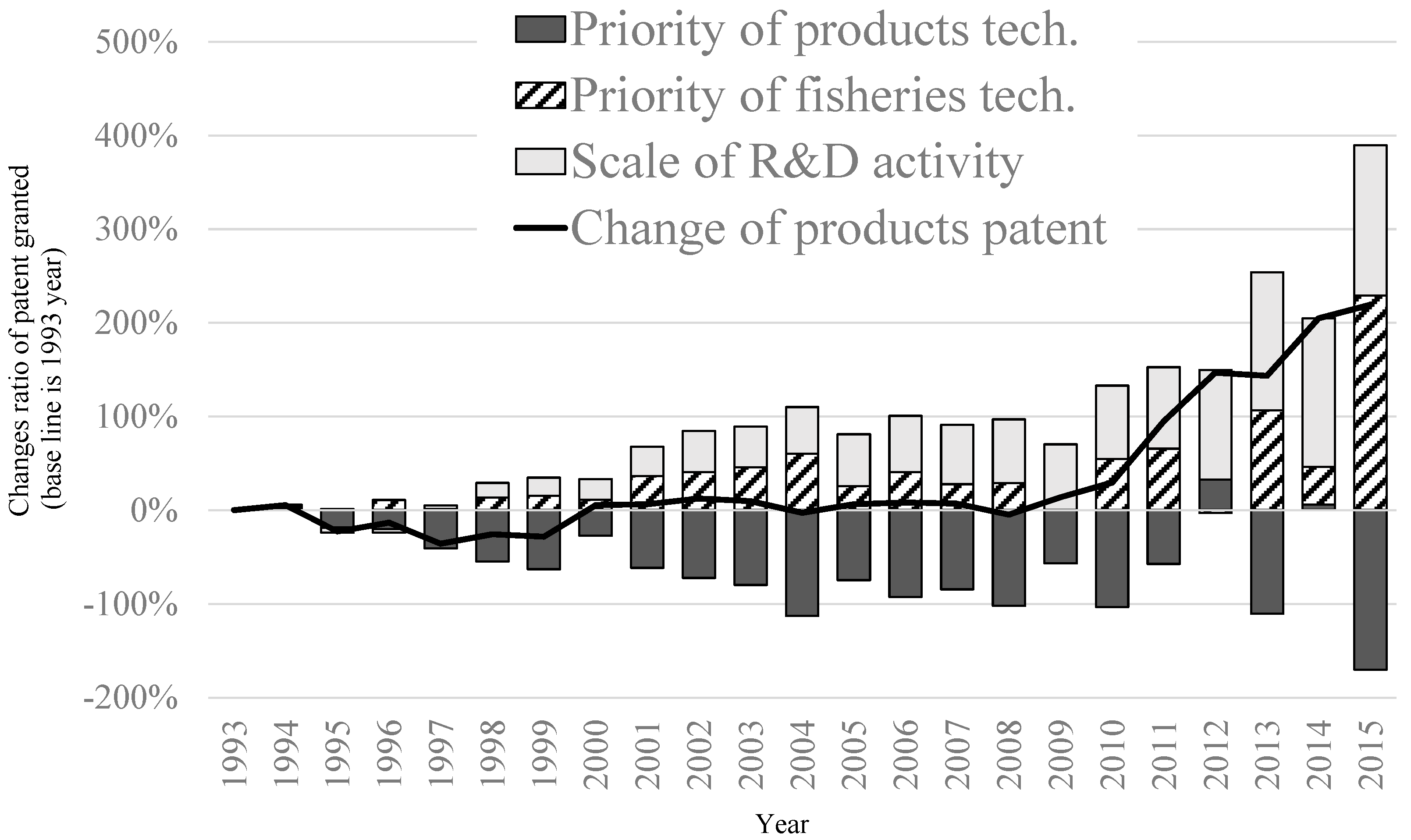Research and Development Strategy for Fishery Technology Innovation for Sustainable Fishery Resource Management in North-East Asia
Abstract
1. Introduction
2. Materials and Methods
3. Data
4. Results and Discussion
4.1. Trend in Fishery Technology Patents Granted
4.2. Results of Decomposition Analysis
4.2.1. Harvesting Technology
4.2.2. Aquaculture Technology
4.2.3. New Products Technology
4.3. Investigation of Research Hypotheses
5. Conclusions
Supplementary Materials
Acknowledgments
Author Contributions
Conflicts of Interest
References
- World Bank. Fish to 2030: Prospects for Fisheries and Aquaculture; Agriculture and Environmental Service Discussion Paper 3, WorldBank Report Number 83177-GLB; World Bank: Washington, DC, USA, 2016. [Google Scholar]
- Food and Agriculture Organization of the United Nations (FAO). The State of World Fisheries and Aquaculture 2016 (SOFIA): Contributing to Food Security and Nutrition for All; Food and Agriculture Organization: Rome, Italy, 2016. [Google Scholar]
- De Leo, F.; Miglietta, P.P.; Pavlinović, S. Marine ecological footprint of Italian Mediterranean fisheries. Sustainability 2014, 6, 7482–7495. [Google Scholar] [CrossRef]
- Jennings, S.; Stentiford, G.D.; Leocadio, A.M.; Jeffery, K.R.; Metcalfe, J.D.; Katsiadaki, I.; Auchterlonie, N.A.; Mangi, S.C.; Pinnegar, J.K.; Ellis, T.; et al. Aquatic food security: Insights into challenges and solutions from an analysis of interactions between fisheries, aquaculture, food safety, human health, fish and human welfare, economy and environment. Fish Fish. 2016, 17, 893–938. [Google Scholar] [CrossRef]
- Food and Agriculture Organization of the United Nations (FAO). World Review of Fisheries and Aquaculture; FAO: Rome, Italy, 2014. [Google Scholar]
- De Leo, F.; Miglietta, P.P.; Pavlinović, S. Marine fisheries and mariculture in Croatia: Economic and trade analysis. J. Econ. Financ. Stud. 2014, 2, 53–61. [Google Scholar] [CrossRef]
- Salomon, M.; Holm-Müller, K. Towards a sustainable fisheries policy in Europe. Fish Fish. 2013, 14, 625–638. [Google Scholar] [CrossRef]
- United Nations. Transforming Our World: The 2030 Agenda for Sustainable Development. Outcome Document for the United Nations Summit to Adopt the Post-2015 Development Agenda. 2015. Available online: https://sustainabledevelopment.un.org/post2015/transformingourworld (accessed on 16 November 2017).
- Eigaard, O.R.; Marchal, P.; Gislason, H.; Rijnsdorp, A.D. Technological development and fisheries management. Rev. Fish. Sci. Aquac. 2014, 22, 156–174. [Google Scholar] [CrossRef]
- Burnell, G.; Allan, G. New Technologies in Aquaculture: Improving Production Efficiency, Quality and Environmental Management; Woodhead Publishing Limited: Oxford, UK, 2009. [Google Scholar]
- Martín-Sánchez, A.M.; Navarro, C.; Pérez-Álvarez, J.A.; Kuri, V. Alternatives for efficient and sustainable production of surimi: A review. Compr. Rev. Food Sci. Food Saf. 2009, 8, 359–374. [Google Scholar] [CrossRef]
- Suuronen, P.; Chopin, F.; Glass, C.; Løkkeborg, S.; Matsushita, Y.; Queirolo, D.; Rihan, D. Low impact and fuel efficient fishing—Looking beyond the horizon. Fish. Res. 2012, 119–120, 135–146. [Google Scholar] [CrossRef]
- Lubchenco, J.; Grorud-Colvert, K. Making waves: The science and politics of ocean protection. Science 2015, 350, 382–383. [Google Scholar] [CrossRef] [PubMed]
- Organization for Economic Co-Operation and Development. OECD Stat. Fisheries International Collaboration in Technology Development (Bilateral). 2015. Available online: http://stats.oecd.org/OECDStat_Metadata/ShowMetadata.ashx?DataSet=FISH_PAT_COL (accessed on 16 November 2017).
- Candelin-Palmqvist, H.; Sandberg, B.; Mylly, U.-M. Intellectual property rights in innovation management research: A review. Technovation 2012, 32, 502–512. [Google Scholar] [CrossRef]
- Nicol, S.; Foster, J.; Kawaguchi, S. The fishery for Antarctic krill—Recent developments. Fish Fish. 2012, 13, 30–40. [Google Scholar] [CrossRef]
- Popp, D. Induced innovation and energy prices. Am. Econ. Rev. 2002, 92, 160–180. [Google Scholar] [CrossRef]
- Fujii, H. Decomposition analysis of green chemical technology inventions from 1971 to 2010 in Japan. J. Clean. Prod. 2016, 112, 4835–4843. [Google Scholar] [CrossRef]
- Ninan, S.; Sharma, A.; Ananthan, P.S.; Ojha, S.N. Intellectual property right in fisheries sector. J. Intellect. Prop. Rights 2005, 10, 52–58. [Google Scholar]
- Ninan, S.; Sharma, A. Cross-sectional analysis of patents in Indian fisheries sector. World Pat. Inf. 2006, 28, 147–158. [Google Scholar] [CrossRef]
- Fujii, H.; Managi, S. Research and development strategy for environmental technology in Japan: A comparative study of the private and public sectors. Technol. Forecast. Soc. Chang. 2016, 112, 293–302. [Google Scholar] [CrossRef]
- Gorospe, K.D.; Michaels, W.; Pomeroy, R.; Elvidge, C.; Lynch, P.; Wongbusarakum, S.; Brainard, R.E. The mobilization of science and technology fisheries innovations towards an ecosystem approach to fisheries management in the Coral Triangle and Southeast Asia. Mar. Policy 2016, 74, 143–152. [Google Scholar] [CrossRef]
- Rickels, W.; Dovern, J.; Quaas, M. Beyond fisheries: Common-pool resource problems in oceanic resources and services. Glob. Environ. Chang. 2016, 40, 37–49. [Google Scholar] [CrossRef]
- Ang, B.W.; Zhang, F.Q.; Choi, K.-H. Factorizing changes in energy and environmental indicators through decomposition. Energy 1998, 23, 489–495. [Google Scholar] [CrossRef]
- Dang, J.; Motohashi, K. Patent statistics: A good indicator for innovation in China? Patent subsidy program impacts on patent quality. China Econ. Rev. 2015, 35, 137–155. [Google Scholar] [CrossRef]
- Hu, A.G.Z.; Zhang, P.; Zhao, L. China as number one? Evidence from China’s most recent patenting surge. J. Dev. Econ. 2017, 124, 107–119. [Google Scholar] [CrossRef]
- Holcombe, R.G. South Korea’s economic future: Industrial policy, or economic democracy? J. Econ. Behav. Organ. 2013, 88, 3–13. [Google Scholar] [CrossRef]
- Kim, Y. From catch-up to overtaking: Competition and innovation in the semiconductor industries of Korea and Japan. Asian J. Technol. Innov. 2011, 19, 297–311. [Google Scholar] [CrossRef]
- Huang, C.; Wu, Y. State-led technological development: A case of China’s nanotechnology development. World Dev. 2012, 40, 970–982. [Google Scholar] [CrossRef]
- Fong, P.S.W.; Chang, X.; Chen, Q. Faculty patent assignment in the Chinese mainland: Evidence from the top 35 patent application universities. J. Technol. Transf. 2015, 1–27. [Google Scholar] [CrossRef]
- Ministry of Agriculture, Forestry and Fisheries. The 2013 Census of Fisheries. 2016. Available online: http://www.e-stat.go.jp/SG1/estat/ListE.do?bid=000001067819&cycode=0 (accessed on 16 February 2017).
- Ito, F. Course of the research for sustainable aquaculture in Japan. Bull. Jpn. Fish. Res. Educ. Agency 2012, 35, 1–5. [Google Scholar]
- Uchida, H.; Onozaka, Y.; Morita, T.; Managi, S. Demand for ecolabeled seafood in the Japanese market: A conjoint analysis of the impact of information and interaction with other labels. Food Policy 2014, 44, 68–76. [Google Scholar] [CrossRef]
- Food and Agriculture Organization of the United Nations (FAO). Market. Competition between Farmed and Wild Fish: A Literature Survey; FAO Fisheries and Aquaculture, FAO Fisheries and Aquaculture Circular No. 1114; FAO: Rome, Italy, 2016. [Google Scholar]
- Claret, A.; Guerrero, L.; Gartzia, I.; Garcia-Quiroga, M.; Ginés, R. Does information affect consumer liking of farmed and wild fish? Aquaculture 2016, 454, 157–162. [Google Scholar] [CrossRef]
- Fisheries Agency of Japan. White Paper on Fisheries FY2015. 2015. Available online: http://www.jfa.maff.go.jp/j/kikaku/wpaper/pdf/hakusyo2014e.pdf (accessed on 16 November 2017).
- Villasante, S.; Rodriguez-Gonzalez, D.; Antelo, M.; Rivero-Rodriguez, S.; de Santiago, J.A.; Macho, G. All fish for China? Ambio 2013, 42, 923–936. [Google Scholar] [CrossRef] [PubMed]
- Organization for Economic Co-Operation and Development. Review of Fisheries: Country Statistics; OECD Publishing: Paris, France, 2015. [Google Scholar]



| Patent Group | Description of Patent Group |
|---|---|
| Harvesting technology | Harvesting technologies, such as more effective ways to find or harvest fish; these are typically associated with improvements in catch per unit of effort. The main categories of this patent group are IPC = A01K69 (Stationary catching devices), IPC = A01K77 (Landing-nets; Landing-spoons), and IPC = B63B35/14 (Fishing vessels). |
| Aquaculture technology | Aquaculture technologies, such as methods to more effectively grow fish in captivity (innovation in feeds, ingredients that improve the health of aquaculture animals, etc.). The main categories of this patent group are IPC = A01K61 (Culture of fish, mussels, crayfish, lobsters, sponges, pearls and the like) and IPC = A01K63 (Receptacles for live fish, e.g., aquaria). |
| New products technology | New products technologies, such as the development of new fish products (food technologies/processing, such as the development of surimi as a crabmeat substitute) and improvement in processing lines. The main categories of this patent group are IPC = A22C25 (Processing fish; curing of fish; stunning of fish by electric current; investigating fish by optical means) and IPC = A22C29 (Processing shellfish or bivalves and devices therefor; processing lines). |
| Country and Region | Fisheries Technology Patents | Breakdown by Technology Type (%) | |||
|---|---|---|---|---|---|
| Number of Patent Granted (Item) | Share (%) | Harvesting | Aquaculture | Products | |
| China | 50,914 | 42.06% | 22% | 74% | 3% |
| Korea, Republic of | 15,879 | 13.12% | 56% | 40% | 4% |
| Japan | 15,212 | 12.57% | 50% | 46% | 4% |
| World 1 | 121,059 | 100.00% | 35% | 61% | 4% |
| Technology | Country | 1993–1997 | 1998–2002 | 2003–2007 | 2008–2012 | 2013–2015 |
|---|---|---|---|---|---|---|
| Harvest | China | 184 | 929 | 1801 | 3363 | 5293 |
| Korea | 759 | 2977 | 2317 | 1786 | 1463 | |
| Japan | 845 | 1056 | 2690 | 2166 | 1156 | |
| World | 3427 | 6207 | 8552 | 8167 | 10,336 | |
| Aquaculture | China | 525 | 1180 | 3149 | 10,635 | 22,690 |
| Korea | 376 | 1485 | 1648 | 1713 | 1353 | |
| Japan | 1083 | 1214 | 2522 | 1396 | 1124 | |
| World | 3472 | 5942 | 11,735 | 14,945 | 28,321 | |
| Product | China | 27 | 37 | 105 | 552 | 912 |
| Korea | 38 | 140 | 183 | 124 | 123 | |
| Japan | 247 | 134 | 129 | 81 | 87 | |
| World | 536 | 519 | 611 | 774 | 1384 |
| Change in Harvesting Tech. | Decomposed Factors | Most Increased Patent Technology (IPC) | |||
|---|---|---|---|---|---|
| Priority of Harvesting Tech. | Priority of Fisheries Tech. | Scale | |||
| China | 1841 | −1201 | 1125 | 1917 | Accessories for angling (A01K97) |
| Korea | 115 | −214 | −102 | 431 | Accessories for angling (A01K97) |
| Japan | 97 | 128 | 163 | −194 | Reels (A01K89) |
| World | 2327 | −2477 | 2516 | 2287 | Systems using the reflection of acoustic waves (G01S15) |
| Change in Aquaculture Tech. | Decomposed Factors | Most Increased Patent Technology (IPC) | |||
|---|---|---|---|---|---|
| Priority of Aquaculture Tech. | Priority of Fisheries Tech. | Scale | |||
| China | 11,736 | 1441 | 4949 | 5346 | Animal feeding stuffs for aquatic animals (A23K1) |
| Korea | 231 | 192 | −164 | 202 | Culture of fish, mussels, crayfish, lobsters, sponges, pearls or the like (A01K61) |
| Japan | 82 | −46 | 278 | −149 | Rearing or breeding animals not otherwise provided for (A01K67) |
| World | 12,769 | 2884 | 6262 | 3623 | Animal feeding stuffs for aquatic animals (A23K1) |
| Change in Products Technology | Decomposed Factors | Most Increased Patent Technology (IPC) | |||
|---|---|---|---|---|---|
| Priority of Products Technology | Priority of Fisheries Technology | Scale | |||
| China | 345 | −116 | 213 | 248 | Processing fish (A22C25) |
| Korea | 26 | 16 | −10 | 20 | Processing fish (A22C25) |
| Japan | −57 | −77 | 33 | −12 | Both technology groups decreased |
| World | 318 | −247 | 332 | 232 | Processing shellfish or bivalves (A22C29) |
© 2017 by the authors. Licensee MDPI, Basel, Switzerland. This article is an open access article distributed under the terms and conditions of the Creative Commons Attribution (CC BY) license (http://creativecommons.org/licenses/by/4.0/).
Share and Cite
Fujii, H.; Sakakura, Y.; Hagiwara, A.; Bostock, J.; Soyano, K.; Matsushita, Y. Research and Development Strategy for Fishery Technology Innovation for Sustainable Fishery Resource Management in North-East Asia. Sustainability 2018, 10, 59. https://doi.org/10.3390/su10010059
Fujii H, Sakakura Y, Hagiwara A, Bostock J, Soyano K, Matsushita Y. Research and Development Strategy for Fishery Technology Innovation for Sustainable Fishery Resource Management in North-East Asia. Sustainability. 2018; 10(1):59. https://doi.org/10.3390/su10010059
Chicago/Turabian StyleFujii, Hidemichi, Yoshitaka Sakakura, Atsushi Hagiwara, John Bostock, Kiyoshi Soyano, and Yoshiki Matsushita. 2018. "Research and Development Strategy for Fishery Technology Innovation for Sustainable Fishery Resource Management in North-East Asia" Sustainability 10, no. 1: 59. https://doi.org/10.3390/su10010059
APA StyleFujii, H., Sakakura, Y., Hagiwara, A., Bostock, J., Soyano, K., & Matsushita, Y. (2018). Research and Development Strategy for Fishery Technology Innovation for Sustainable Fishery Resource Management in North-East Asia. Sustainability, 10(1), 59. https://doi.org/10.3390/su10010059





